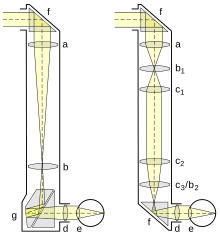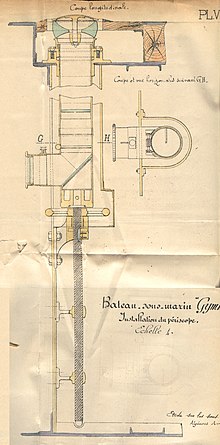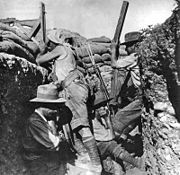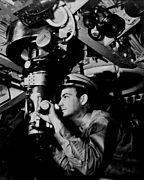Periscope

aMirrors
bPrisms
cObserver's eye

aObjective lens
bField lens
cImage erecting lens
dOcular lens
eLens of the observer's eye
fRight-angled prism
gImage-erecting prism
Aperiscopeis an instrument for observation over, around or through an object, obstacle or condition that prevents direct line-of-sight observation from an observer's current position.[1][2]
In its simplest form, it consists of an outer case withmirrorsat each end set parallel to each other at a 45° angle. This form of periscope, with the addition of two simple lenses, served for observation purposes in the trenches duringWorld War I.Military personnel also use periscopes in somegun turretsand inarmoured vehicles.[1]
More complex periscopes usingprismsor advancedfiber opticsinstead of mirrors and providing magnification operate onsubmarinesand in various fields of science. The overall design of the classical submarine periscope is very simple: two telescopes pointed into each other. If the two telescopes have different individual magnification, the difference between them causes an overall magnification or reduction.
Early examples[edit]
Johannes Heveliusdescribed an early periscope (which he called a "polemoscope" ) with lenses in 1647 in his workSelenographia, sive Lunae descriptio[Selenography, or an account of the Moon]. Hevelius saw military applications for his invention.
Mikhail Lomonosovinvented an "optical tube" which was similar to a periscope. In 1834, it was used in a submarine, designed by Karl Andreevich Schilder.[3]
In 1854,Hippolyte Marié-Davyinvented the first naval periscope, consisting of a vertical tube with two small mirrors fixed at each end at 45°.Simon Lakeused periscopes in his submarines in 1902.Sir Howard Grubbperfected the device in World War I.[4]Morgan Robertson(1861–1915) claimed[5]to have tried to patent the periscope: he described a submarine using a periscope in his fictional works.
Periscopes, in some cases fixed torifles,served inWorld War I(1914–1918) to enable soldiers to see over the tops oftrenches,thus avoiding exposure to enemy fire (especially from snipers).[6]Theperiscope riflealso saw use during the war – this was an infantry rifle sighted by means of a periscope, so the shooter could aim and fire the weapon from a safe position below the trench parapet.
DuringWorld War II(1939–1945), artillery observers and officers used specifically manufactured periscope binoculars with different mountings. Some of them also allowed estimating the distance to a target, as they were designed asstereoscopic rangefinders.[citation needed]
-
An Auxiliary Periscope for Submarines fromThe Electrical Experimenter,Vol. IV, No. 38., 1916
-
A team of Germanartillery observersusingperiscope binoculars,1943
Armored vehicle periscopes[edit]
Tanksand armoured vehicles use periscopes: they enable drivers, tank commanders, and other vehicle occupants to inspect their situation through the vehicle roof. Prior to periscopes, direct vision slits were cut in the armour for occupants to see out. Periscopes permit view outside of the vehicle without needing to cut these weaker vision openings in the front and side armour, better protecting the vehicle and occupants.
A protectoscope is a related periscopic vision device designed to provide a window in armoured plate, similar to a direct vision slit. A compact periscope inside the protectoscope allows the vision slit to be blanked off with spaced armoured plate. This prevents a potential ingress point for small arms fire, with only a small difference in vision height, but still requires the armour to be cut.
In the context ofarmoured fighting vehicles,such astanks,a periscopic vision device may also be referred to as anepiscope.In this context a periscope refers to a device that can rotate to provide a wider field of view (or is fixed into an assembly that can), while an episcope is fixed into position.
Periscopes may also be referred to by slang, e.g. "shufti-scope".[7]
Gundlach and Vickers 360-degree periscopes[edit]
An important development, theGundlach rotary periscope,incorporated a rotating top with a selectable additional prism which reversed the view. This allowed a tank commander to obtain a 360-degree field of view without moving his seat, including rear vision by engaging the extra prism. This design, patented byRudolf Gundlachin 1936, first saw use in thePolish7-TPlight tank (produced from 1935 to 1939).
As a part of Polish–British pre-World War IImilitary cooperation, the patent was sold to Vickers-Armstrong where it saw further development for use inBritishtanks, including theCrusader,Churchill,Valentine,andCromwellmodels as theVickers Tank Periscope MK.IV.
The Gundlach-Vickers technology was shared with theAmerican Armyfor use in its tanks including theSherman,built to meet joint British and US requirements. This saw post-war controversy through legal action: "After the Second World War and a long court battle, in 1947 he, Rudolf Gundlach, received a large payment for his periscope patent from some of its producers."[8]
TheUSSRalso copied the design and used it extensively in its tanks, including theT-34andT-70.The copies were based on Lend-Lease British vehicles, and many parts remain interchangeable.Germanyalso made and used copies.[8]
Periscopic gun-sights[edit]
Periscopicsightswere also introduced during the Second World War. In British use, the Vickers periscope was provided with sighting lines, enabling front and rear prisms to be directly aligned to gain an accurate direction. On later tanks such as the Churchill and Cromwell, a similarly marked episcope provided a backup sighting mechanism aligned with a vane sight on the turret roof.
Later, US-built Sherman tanks and BritishCenturionandCharioteertanks replaced the main telescopic sight with a true periscopic sight in the primary role. The periscopic sight was linked to the gun itself, allowing elevation to be captured (rotation being fixed as part of rotating turret). The sights formed part of the overall periscope, providing the gunner with greater overall vision than previously possible with the telescopic sight. TheFV4201 Chieftainused the TESS (TElescopic Sighting System) developed in the early 1980s that was later sold as surplus for use on theRAF Phantomaircraft.[9][10]
Modern specialised AFV periscopes[edit]
In modern use, specialised periscopes can also provide night vision. The Embedded Image Periscope (EIP) designed and patented by Kent Periscopes provides standard unity vision periscope functionality for normal daytime viewing of the vehicle surroundings plus the ability to display digital images from a range of on-vehicle sensors and cameras (including thermal and low light) such that the resulting image appears "embedded" internally within the unit and projected at a comfortable viewing positions.
[edit]

Periscopes allow asubmarine,when submerged at a relatively shallow depth, to search visually for nearby targets and threats on the surface of the water and in the air. When not in use, a submarine's periscope retracts into thehull.A submarine commander in tactical conditions must exercise discretion when using his periscope, since it creates a visible wake (and may also become detectable byradar),[11][12]giving away the submarine's position.
Marie-Davey built a simple, fixed naval periscope using mirrors in 1854. Thomas H. Doughty of theUnited States Navylater invented a prismatic version for use in theAmerican Civil Warof 1861–1865.
Submarines adopted periscopes early. CaptainArthur Krebsadapted two on the experimental French submarineGymnotein 1888 and 1889. The Spanish inventorIsaac Peralequipped his submarinePeral(developed in 1886 but launched on September 8, 1888) with a fixed, non-retractable periscope that used a combination of prisms to relay the image to the submariner. (Peral also developed a primitivegyroscopefor submarine navigation and pioneered the ability to fire livetorpedoeswhile submerged.[13][unreliable source?])
The invention of the collapsible periscope for use in submarine warfare is usually credited[by whom?]toSimon Lakein 1902. Lake called his device the "omniscope" or "skalomniscope".[citation needed]
As of 2009[update]modern submarine periscopes incorporate lenses for magnification and function astelescopes.They typically employprismsandtotal internal reflectioninstead of mirrors, because prisms, which do not require coatings on the reflecting surface, are much more rugged than mirrors. They may have additional optical capabilities such asrange-findingand targeting. The mechanical systems of submarine periscopes typically usehydraulicsand need to be quite sturdy to withstand the drag through water. The periscope chassis may also support a radio or radar antenna.
Submarines traditionally had two periscopes; a navigation or observation periscope and a targeting, or commander's, periscope. Navies originally mounted these periscopes in theconning tower,one forward of the other in the narrow hulls of diesel-electric submarines. In the much wider hulls of recent[update]US Navy submarines the two operate side-by-side. The observation scope, used to scan the sea surface and sky, typically had a wide field of view and no magnification or low-power magnification. The targeting or "attack" periscope, by comparison, had a narrower field of view and higher magnification. In World War II and earlier submarines it was the only means of gathering target data to accurately fire a torpedo, sincesonarwas not yet sufficiently advanced for this purpose (ranging with sonar required emission of an acoustic "ping" that gave away the location of the submarine) and most torpedoes were unguided.
Twenty-first-century submarines do not necessarily have periscopes. The United States Navy'sVirginia-class submarinesand theRoyal Navy'sAstute-class submarinesinstead usephotonics masts,[14]pioneered by the Royal Navy'sHMSTrenchant,which lift an electronic imaging sensor-set above the water. Signals from the sensor-set travel electronically to workstations in the submarine's control center. While the cables carrying the signal must penetrate the submarine's hull, they use a much smaller and more easily sealed—and therefore less expensive and safer—hull opening than those required by periscopes. Eliminating the telescoping tube running through the conning tower also allows greater freedom in designing the pressure hull and in placing internal equipment.
-
Officer at periscope in control room of a U.S. Navy submarine in World War II
-
Submarine monocular attack periscope
-
Torpedoed Japanese destroyerYamakazephotographed through periscope ofUSSNautilus,25 June 1942.
Aircraft use[edit]
Periscopes have also been used on aircraft for sections with limited view. The first known use of aircraft periscope was on theSpirit of St. Louis.TheVickers VC10had a periscope that could be used on four locations of the aircraft fuselage,[15]V-Bomberssuch as theAvro VulcanandHandley Page Victor[16]and theNimrod MR1as the "on top sight".[17]Various US bomber aircraft such as theB-52used sextant periscopes forcelestial navigationbefore the introduction ofGPS.[18]This also allowed the aircrew to navigate without the use of anastrodomein the fuselage.[19][20]An emergency periscope was used on all Boeing 737 models manufactured before 1997 found under "Seat D" behind the over wing exit row to regulate the landing gear. High speed andhypersonic aircraftsuch as theNorth American X-15used a periscope.
-
TESS (TElescopic Sighting System) panel mounted periscope between front and rear cockpit on a Royal Air ForceF-4 Phantom II
See also[edit]
References[edit]
- ^abWalker, Bruce H. (2000).Optical Design for Visual Systems.SPIE Press. p. 117.ISBN978-0-8194-3886-7.
- ^The Submarine Periscope: An Explanation of the Principles Involved in Its Construction, Together with a Description of the Main Features of the Barr and Stroud Periscopes.Barr and Stroud Limited. 1928.
- ^"H I Sutton - Covert Shores".hisutton.Retrieved2024-05-23.
- ^The History of the Periscope – Inventors.About
- ^Robertson, Morgan (March 26, 1913)The Schenectady Gazette,Friday morning, p. 19
- ^Willmott, H.P. (2003) First World War.Dorling Kindersley.p. 111.ISBN1405300299
- ^Partridge, Eric (2006).A Dictionary of Slang and Unconventional English.Routledge. pp. 1065–.ISBN978-1-134-96365-2.
- ^abŁukomski, Grzegorz and Stolarski, Rafał E. (1999)Nie tylko Enigma... Mjr Rudolf Gundlach (1892–1957) i jego wynalazek(Not Only Enigma... Major Rudolf Gundlach (1892–1957) and His Invention), Warsaw-London.
- ^"TESS:: David Gledhill".
- ^"The Way of the J. – British Phantom Aviation Group".
- ^Petty, Dan."The US Navy – Fact File: AN/SPS-74(V) Radar Set".navy.mil.Archived fromthe originalon 2019-02-14.Retrieved2017-11-29.
- ^Ousborne, Jeffrey; Griffith, Dale; Yuan, Rebecca W. (1997)."A Periscope Detection Radar"(PDF).Johns Hopkins APL Technical Digest.18:125. Archived fromthe original(PDF)on 2017-08-08.Retrieved2017-11-29.
- ^"El Arma Submarina Española".Archived fromthe originalon 2009-12-17.Retrieved2009-10-21.
- ^War at Sea and in the Air.Britannica Educational Publishing. 1 November 2011. p. 65.ISBN978-1-61530-753-1.
- ^"Oddities & Innovations".
- ^"Bob's Tale of Phantoms – Victor XM715".
- ^Wilson, Michael (1968-06-13)."Hawker Siddeley Nimrod MR.1".Flight International.p. 892.Archivedfrom the original on 2023-12-25.
- ^"Periscope Aircraft Sextant | Pritzker Military Museum & Library | Chicago".
- ^Reichel, Jack."Perscopic Sextant".ION Navigation Museum.Archivedfrom the original on 2023-07-05.
- ^Campbell, Charles J.; McEachern, Lawrence J.; Marg, Elwin (1956)."Aircraft Flight by an Optical Periscope".Journal of the Optical Society of America.46(11): 944.doi:10.1364/JOSA.46.000944.
External links[edit]
- The Fleet Type Submarine Online: Submarine Periscope ManualUnited States NavyNavpers 16165,June 1979
- Simulation of a PeriscopeatNTNUJAVA Virtual Physics Laboratory
- Periscope used for Celestial Navigation in Petan.net
- Air Facts
- THE V-FORCE
- Air Navigation Periscope Sextants
- Periscope Sextant in a Douglas DC-8







